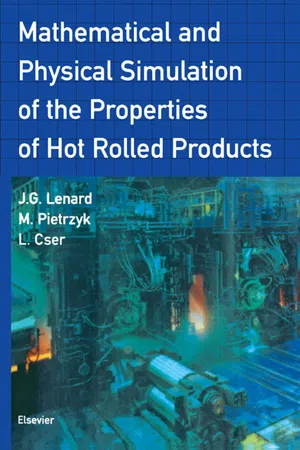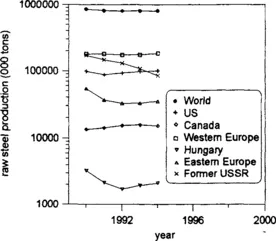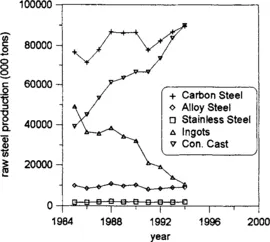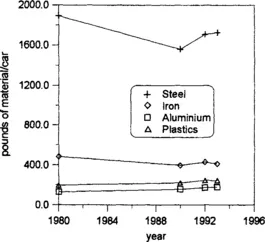![]()
Chapter 1
Introduction
The contribution of manufacturing to the gross national product in an industrialized country is a good, albeit not exclusive, indication of its rank among the developed or developing nations. Schey shows some interesting information in his text Introduction to Manufacturing Processes, 2nd ed. (Schey, 1987) by plotting the contribution of manufacturing to the GNP as a function of the gross national product per capita. The figure indicates Germany as the leader, followed by Switzerland and Japan, Italy, France and the USA. The Canadian contribution, in 1982, was near 20%. At the low end of the scale are the developing nations, including Bangladesh, Zaire and Ethiopia.
Using data from the World Development Report 1997, published by the World Bank (1997), the situation in 1995 is indicated in Figure 1.1. Singapore and China have become major manufacturing nations. As well, Japan has the highest gross domestic product (GDP) per capita income of all nations. At the lower end, developing countries indicate fairly low contribution from manufacturing to their GDP.
Figure 1.1 The contribution of manufacturing to the GDP, 1995
In this chapter, the steel industry, a major contributor to the wealth, is discussed in terms of its capabilities and production. Data concerning raw steel capacity and raw steel production are included and discussed. The current concerns of the major steel producers are mentioned. These include the protection of the environment, competition from minimills, upgrading the quality of the product by improving the adaptive control systems, introducing tool steel rolls to reduce roll wear and investigating the possibilities of direct casting and rolling thin strips.
In the words of the former Director of Research of The Steel Company of Canada, Mr. J.C. McKay (1988) … “there is no material like steel”. Its strength, ductility and formability are unmatched by others and Mr. McKay did not think that the competition from aluminum or ceramics is to be taken as a threat at the present time. While the last comment is arguable, it is true that as of now, the formability of aluminum does not approach that of steel, nor does the ductility of ceramics.
1.1 STEEL PRODUCTION
It is of some interest to examine the international situation in terms of raw steel production by steel grade, method of casting and amounts of production. These data are shown in Figures 1.2 and 1.3, giving the total amount of steel production by selected countries and the breakdown by type and method of casting.
Figure 1.2 Production of raw steel in the world
Figure 1.3 Raw steel production by steel type and by billet preparation
It is quite apparent that while total steel production has been declining during the last five years, this decline was limited to approximately 6%. Minor increases are observable in the amount of steel produced in North America and in Western Europe. There is a very serious drop in the steel production data of the former USSR; from a high of 170 million tons in 1990 to 86 million tons in 1994. Surprisingly, this drop was not filled in by the steel companies of the West. Hungary’s steel production showed a drop from 1990 when the total was 3.2 million tons, to a low of 1.9 million tons in 1993. There is a marginal increase evident in 1994, to 2.1 million tons.
The breakdown of the production data indicates several changes in the way steel is produced. Figure 1.3 shows some of the trends, presenting information on the types of steel produced and the favoured method of preparing the slabs for hot rolling. The data refers to steel production in the United States only.
There was significant evidence up to the middle of the 1980s that industrialized nations produced and rolled less carbon steels and more alloy steels, reflecting a concentration on the value added product of the higher priced steels. At the same time, less developed nations were increasing their share of the carbon steel markets but did not have the technology necessary to produce the steels requiring careful thermal-mechanical treatment, or in other words, controlled rolling. Figure 1.3 above shows a deviation from this trend. The amount of carbon steel produced has been growing over the last few years, while the amounts of alloy and stainless steels produced have not changed in a very significant manner. The data do not show the current concerns of customers, however. Among the carbon steels, two new types are involved: the coated steels, especially galvanized steels, which reduce the effects of corrosion, produced for the automotive market, and the extra low carbon steels, containing 0.002 − 0.004% C, necessitating rolling in the two-phase or the ferrite temperature ranges. Both of these steel types need the extra skill and technology possessed by the companies of the industrialized nations.
As well, the method of producing billets has changed drastically. In 1985 almost 50 million tons of steel were prepared from ingots and about 40 million tons by continuous casting. In 1994, the situation is reversed and continuous casting is used in almost 95% of production, indicating the cost saving introduced by the technology change. As mentioned above, the information in Figure 1.3 refers to the United States only. It may be assumed with some assurance, however, that the trends are universal.
1.2 FUTURE CHANGES IN PERSONNEL
The Canadian Steel Trade and Employment Congress is a joint initiative of the United Steelworkers of America and Canada’s steel companies. In a recent brochure (Steel in Our Future, 1995) the Congress stated its views on the future of steel in North America, referring to the United States, Canada and Mexico.
The brochure discusses the changing face of the steel trade. It comments on the “customer-driven” and “environmentally-conscious” technologies one must use. As well, while the basic ideas of steel making and steel producing have not changed, the details of the processes have. The people and the products are vastly different. A direct quotation from the brochure is especially interesting:
“By 1980, you needed a high school education to get a job in the mill. As we approach the year 2000, you will require a post-secondary education”.
In the opinion of the authors and considering the introduction of high technology in the steel industry and the requirement for increasing the value-added component of the product, the statement may be applied universally. The recent cover story in The Economist (The Economist, 1998) also indicates that the nature of manufacturing has changed and now demands highly qualified workers, able to deal with the increased complexities of production.
1.3 COMPETITION FROM OTHER MATERIALS
Steel competes with aluminum, plastics, composites and ceramics and this competition is the fiercest in the automotive industry as over the last decade the pressure for increased fuel economy resulted in the need for lighter weight cars. The competition is not over as the pressure for even lower fuel consumption has not abated.
While there was a considerable change in the amount of steel and iron used in vehicles in favor of the alternatives, there is some evidence that in the recent past, steel has been enjoying increased use. Steel’s ease in manufacturability, advances in optimizing techniques and complete recyclability are the reasons for this comeback (Driving Your Future, 1995).
Some examples indicate the trend. While the original design for the 1996 Sable and Taurus included an aluminum hood and fender, the cars were introduced into the market with steel for those parts. The roof of the 1996 Saturn is made of steel instead of a combination of steel and plastic. The rear subframe of the 1997 Corvette is manufactured from hydroformed steel tubing, instead of aluminum extrusions. Some of these facts are illustrated in Figure 1.4. It is apparent that while steel usage has increased, the amount of the other materials has remained largely unchanged.
Figure 1.4 Competition from other materials
The efforts in the aluminum industry, toward making aluminum competitive with steel, are not to be underestimated. Considerable research is being devoted to studies of the formability of aluminum sheets. The work considers, among others, the process of forming, the tribology problems at the die/metal interface, the development of new alloys in addition to a constant search for improved productivity.
The steel engineers are, of course, aware of the necessary trends toward lighter weight vehicles, as evidenced by the development of the ultra light weight car frame whose performance has exceeded the original specifications.
1.4 CURRENT CONCERNS
Minimills: Dominance of the integrated steel producers is increasingly challenged by the minimills with lower costs of production. Minimill technology emerged in the 1970s, originally used for the production of specialty steels. The small mills have expanded their operations to produce carbon steels in a very short time period. The cost reduction was obtained mostly from producing liquid steel from scrap, using an electric furnace, lowering capital costs per ton of annual steelmaking capacity to one third that of a new integrated mill. Initially, minimills produced no more than half a million tons per year. This amount increased fast, however, and many of them now produce over one million tons.
Protection of the environment: The need for the protection of the environment is realized by steel producers and environmental management is now an integral part of plant management at all modem steel mills. Recycling is built into the steelmaking process. Exampl...




